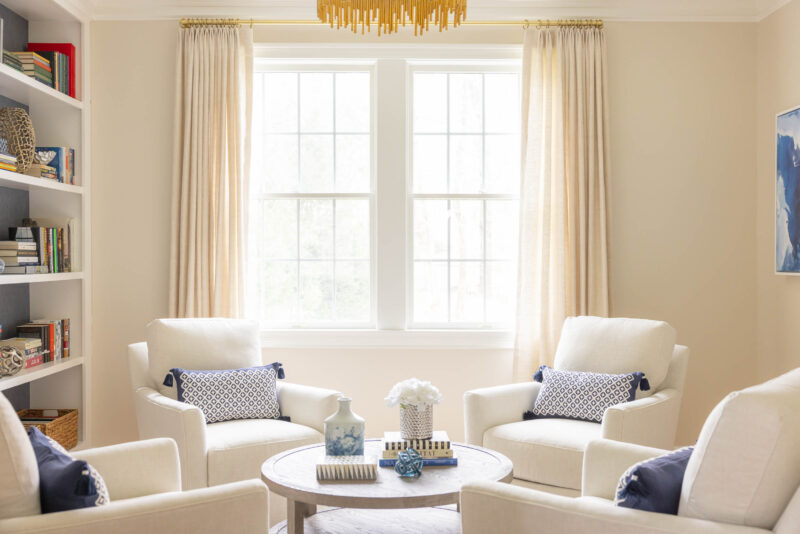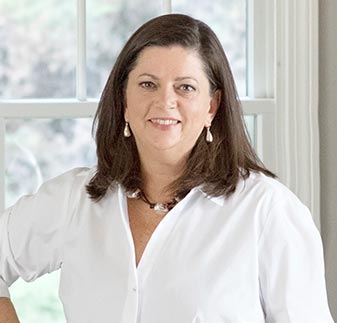
Learn how to style the perfect coffee table.
5 complete looks with shopping links!
Design Mistake #8: No Focal Point

Focal points in a room are essential for building a cohesive design. A focal point is a thing that draws your eye first because it is more dramatic than other points in the room. It’s a visual point of interest that captures our attention and pulls us into the space.

Many things can create focal points:
- Architectural components of a room
- Fireplace
- Windows
- Ceiling
- Bookcases or builtins
- Artwork or groupings of artwork
- Pieces of furniture or groupings of furniture
- Rugs
- Lighting
Rooms can have multiple focal points. This room has a strong fireplace that is layered with a bold piece of art, a large coffee table grounding the sectional with prominent accessories, and pillows that add a pop of color to the seating. All of these are focal points—adding interest to the room and drawing your eye from one thing to the next.
What is equally as important to a room is negative space.
Negative space is just that—an area of the room with nothing or nothing that draws your eye. Negative space is crucial to give your eye a place to rest.
Have you ever walked into a space with so much going on that it made you feel physically overwhelmed or anxious? Too much furniture, things hanging on every wall, stuff covering every table, hardly enough room to walk in the space, piles of things in the corners, etc. I’m sweating just thinking about it. That is an exaggerated example of no negative space, but it was meant to make a point.
When designing your space, the balance between positive space (focal points) and negative space is crucial to creating a balanced and aesthetically pleasing room. The amount of positive vs. negative space is subjective, but it is essential to the design of a room.

So, how do you apply this information to your spaces? Here are some tips:
- Start with your main focal point. Decide what that is, and make it shine! Let’s say it’s your fireplace. Look at the area as a whole to determine what it needs. A fireplace between windows or bookshelves may just need artwork over the mantle. Whereas a fireplace on a long wall may need a painting over the mantle and something flanking both sides of it—it could be gallery walls, a pair of chests with lamps, bookshelves, etc. Work on your main focal point to get it to a place you are happy with.
- Once your main focal point is set, assess your room to see what else it needs. Is there another long, blank wall with no architectural interest? Is there a wall with a pair of widows that needs something between them? Does the rug need to pop? Do some of the surfaces need accessories? Address these secondary spaces next. Build your layers of focal points.
- Stop and live with it for a bit. When we’re changing our spaces, it takes time to adjust to the new surroundings. Live with it and enjoy it for a bit of time.
- Reassess the space to see if it’s all working, needs more, or needs less. A great way to do this is by taking a few photos of the space and printing them out large—like 8 x 10—paper is acceptable. Taking the 3rd dimension out of the room allows us to see things more clearly. Are you drawn to your main focal point, or does it need some adjusting? How do the other areas feel—too crowded, too sparse, or just right? Is anything falling flat or overpowering?
- Remember to leave negative space. Not all walls need art. There can be blank spaces on your coffee table. Not every piece of furniture needs pillows.
As you go through the design process, the best way to understand things is to study them and then try them out.
Designers hone their eye and skill by practicing—every day. We have confidence because we have years of experience. Treat design like anything else you want to learn: study, observe, practice, and work through mistakes.
For inspiration, check out our portfolio page and our Pinterest page.
We’re always talking design on Instagram, so join in by following along here.
And if you would like all things design sent straight to your inbox, sign up for our mailing list.
You’ve just read Design Mistake #8, don’t miss the rest of the Design Mistake series:
#1 Keeping Things You Don’t Love

Hi, I’m Molly Hirsch, and I help women founders, executives, and entrepreneurs translate their highly effective work approach to their home design, creating a space that rises up to meet their needs while enhancing the warmth and style of their family home. Discover all the ways we can work together to create a home of your dreams.
